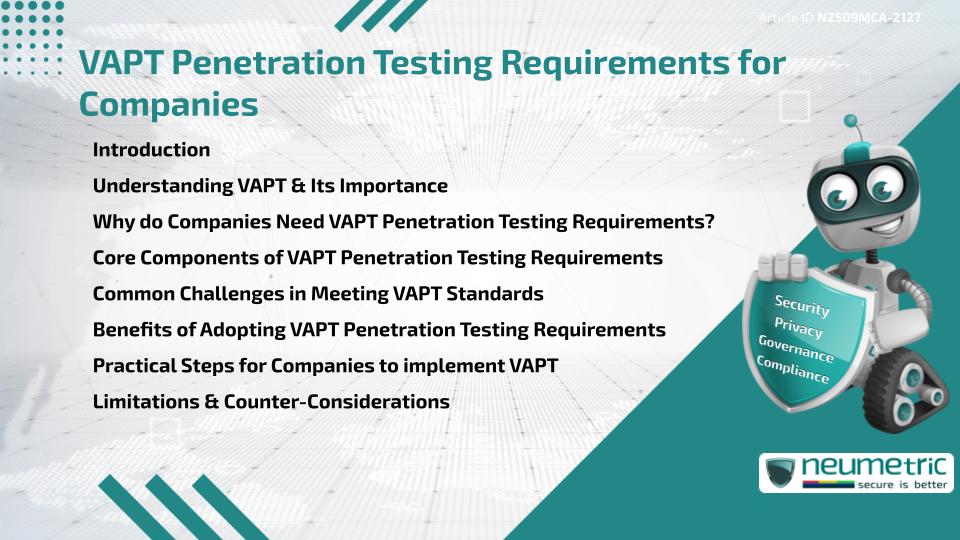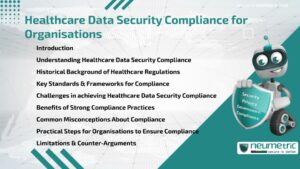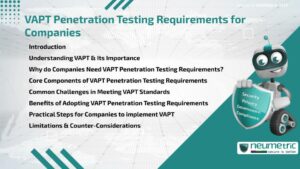Table of Contents
ToggleIntroduction
The VAPT Penetration Testing requirements are essential guidelines that Companies must follow to protect their systems from Vulnerabilities & Cyber Threats. Vulnerability Assessment & Penetration Testing [VAPT] involves scanning, analysing & attempting to exploit weaknesses in IT Infrastructures. These requirements help Companies maintain Data Security, comply with Regulations & build Customer Trust. By following a structured checklist, Organisations can ensure their systems are resilient against potential attacks.
Understanding VAPT & Its Importance
VAPT combines two approaches: Vulnerability Assessment, which identifies Security Flaws & Penetration Testing, which simulates attacks to exploit those flaws. Together, they provide a comprehensive view of a Company’s Security Posture.
Without meeting VAPT Penetration Testing requirements, Businesses leave themselves exposed to Data Breaches, Financial Losses & Reputational Damage. Just like a Health Check identifies Risks before they become illnesses, VAPT reveals Vulnerabilities before they result in real-world Security Incidents.
Why do Companies Need VAPT Penetration Testing Requirements?
Cyberattacks are growing in complexity & frequency. Regulatory Bodies worldwide are emphasising mandatory testing to safeguard Sensitive Data. Companies must meet VAPT Penetration Testing requirements to:
- Ensure Compliance with Industry & Government Standards.
- Detects Vulnerabilities that automated tools alone may miss.
- Prevent exploitation of weak Security Controls.
- Demonstrate accountability to Stakeholders & Customers.
A proper Framework ensures that Security is not left to chance.
Core Components of VAPT Penetration Testing Requirements
An effective checklist should include:
- Scope Definition: Identify Systems, Applications & Networks to be tested.
- Vulnerability Scanning: Use automated tools to detect known weaknesses.
- Manual Testing: Simulate real-world attack scenarios.
- Risk Assessment: prioritise Vulnerabilities based on severity & impact.
- Remediation Plans: Establish Corrective Actions with timelines.
- Reporting: Provide detailed Technical & Executive-Level summaries.
- Compliance Mapping: Align findings with relevant Regulations such as ISO 27001, PCI DSS or GDPR.
These elements make up the backbone of VAPT Penetration Testing requirements for Companies of all sizes.
Common Challenges in Meeting VAPT Standards
While the benefits are clear, Companies often face hurdles in implementing these requirements:
- Limited resources for advanced testing tools.
- Lack of skilled Professionals with expertise in Penetration Testing.
- Resistance to testing due to fear of System Downtime.
- Difficulty integrating VAPT into ongoing Security Programs.
Such challenges highlight why Companies must treat VAPT as a continuous process rather than a one-time exercise.
Benefits of Adopting VAPT Penetration Testing Requirements
Following the requirements provides several advantages:
- Proactively identifies & addresses Vulnerabilities.
- Reduces Risk of Data Breaches & Financial Penalties.
- Strengthens Compliance with Laws & Industry Regulations.
- Builds Customer Trust through demonstrable Security Measures.
- Enhances internal Security Culture & Awareness.
The value extends beyond Compliance, delivering real-world protection & resilience.
Practical Steps for Companies to implement VAPT
Companies can adopt these steps for better implementation:
- Define Objectives & Testing Scope.
- Select qualified External or Internal Testing Providers.
- Schedule regular Testing Cycles, at least annually.
- Integrate findings into Risk Management Frameworks.
- Train Employees to support secure practices.
- Document & track Remediation Efforts.
By consistently following these steps, Businesses align themselves with VAPT Penetration Testing requirements while maintaining stronger defenses.
Limitations & Counter-Considerations
VAPT is not a silver bullet. While it helps uncover Vulnerabilities, it cannot guarantee complete immunity from Cyberattacks. Zero-Day Exploits, Insider Threats or Configuration Errors may still pose Risks. Moreover, the effectiveness of testing depends on Scope, Expertise & Follow-Up Action. Companies should combine VAPT with other layers of Security such as Monitoring, Incident Response & Employee Training.
Conclusion
The VAPT Penetration Testing requirements provide Companies with a structured approach to safeguarding Digital Assets. They help in identifying Vulnerabilities, ensuring Compliance & building Stakeholder Trust. While challenges exist, adopting these requirements as part of a broader Security Program enhances resilience against evolving Threats.
Takeaways
- VAPT combines Assessment & Penetration Testing.
- Requirements ensure Compliance & protection from Risks.
- Core elements include Scope, Scanning, Testing & Remediation.
- Challenges exist but benefits outweigh limitations.
- Continuous Monitoring & layered Security remain essential.
FAQ
What does VAPT stand for?
VAPT stands for Vulnerability Assessment & Penetration Testing, a combined approach to identifying & exploiting System Vulnerabilities.
Why are VAPT Penetration Testing requirements important for Companies?
They are crucial because they reduce Risks, ensure Compliance & protect Businesses from Financial & Reputational Losses.
How often should VAPT be conducted?
Most Companies should conduct VAPT at least once a year or after major System Changes to maintain Security.
Can VAPT guarantee complete protection?
No, VAPT reduces Risks but cannot eliminate all Threats, especially Zero-Day Vulnerabilities or Insider Risks.
Who should perform VAPT for Companies?
Qualified Security Professionals, either Internal Teams or Certified External Providers, should perform VAPT.
Is VAPT mandatory for Compliance?
In many Industries, yes. Standards like PCI DSS, ISO 27001 & certain Regional Regulations require regular Penetration Testing.
What happens if Companies ignore VAPT?
Ignoring VAPT can result in undetected Vulnerabilities, Data Breaches, Non-Compliance Penalties & loss of Customer Trust.
Need help for Security, Privacy, Governance & VAPT?
Neumetric provides organisations the necessary help to achieve their Cybersecurity, Compliance, Governance, Privacy, Certifications & Pentesting needs.
Organisations & Businesses, specifically those which provide SaaS & AI Solutions in the Fintech, BFSI & other regulated sectors, usually need a Cybersecurity Partner for meeting & maintaining the ongoing Security & Privacy needs & requirements of their Enterprise Clients & Privacy conscious Customers.
SOC 2, ISO 27001, ISO 42001, NIST, HIPAA, HECVAT, EU GDPR are some of the Frameworks that are served by Fusion – a SaaS, multimodular, multitenant, centralised, automated, Cybersecurity & Compliance Management system.
Neumetric also provides Expert Services for technical security which covers VAPT for Web Applications, APIs, iOS & Android Mobile Apps, Security Testing for AWS & other Cloud Environments & Cloud Infrastructure & other similar scopes.
Reach out to us by Email or filling out the Contact Form…





